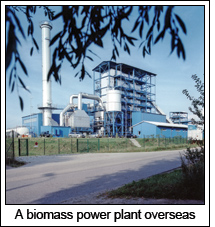
Biomass power generation—the fourth largest energy producer—currently makes up 10 per cent of the world primary energy mix. But the International Energy Agency (IEA) predicts that biomass will become increasingly important as a source of energy, rising to 30 per cent of the world primary energy mix by 2050.
In India, the current capacity of biomass power is only 5 per cent (1,200 mw) as against the total installed capacity based on renewable energy sources of 24,998 mw, as of October 31, 2012. However, MNRE indicates a potential of 18,000 mw from the surplus biomass availability of about 120–150 million tonnes per year, covering agricultural and forestry residues.
Present Situation
In spite of the huge potential identified, the growth is far less when compared to the other renewable energy sources. The existing biomass power plants are battling for their own survival and they are not able to run their plants solely due to unviable sourcing of biomass and also due to the unviable levelized cost of electricity set in as feed-in tariff.
There are four major components that largely determine the tariff for biomass power generation: fuel cost, quality and consumption, equipment cost and performance, the balance of project costs and the cost of capital. The fuel costs and capital costs, including the cost of finance, primarily determine the tariff of biomass-fired power generation. Fuel costs typically account for between 50 per cent and 60 per cent of the tariff, but in reality they are even higher at 80 per cent. This is the sole reason for closure of biomass plants. In some cases, fuel costs have even exceeded tariffs.
Apart from cost, another most important factor in efficient utilization of biomass resource is availability of fuel in close proximity to a biomass power project. The primary reasons for failure of biomass power projects are changes in fuel supply or demand and changes in fuel quality. Another uncertainty facing future development of biomass energy is competition for biomass materials by other industries.
Biomass transportation cost from source constitutes a significant portion of the costs associated with the establishment and running of biomass power plants. There is need for processing in form of shredding the biomass onsite before transportation to increase its density when procurement is done from more than a particular distance. Defragmented nature of agricultural lands does not allow high mechanization which results in reduction of efficiency of collection of biomass and to an increase in procurement cost.
As mentioned earlier, financing and funding for the implementation plays a major role in the sustainability of biomass power plants and the policies which govern the development. Real time experience of the operating biomass-based power plants have shown that the main obstacle in implementing biomass power projects is often not the technical feasibility of these projects but the absence of low-cost, long-term financing.
Banking institutions have unfavourable requirements for biomass power plants financing. Banking institutions normally lay down strict conditions for biomass power plants investors and this deters potential developers.
As shown earlier, limited policy support for biomass power plants in India is indicated by minimal budget allocation to renewables at government level. Consequently, the private sector is left to bear the burden of financing biomass power plants. This is especially true for biomass power plants that have high cost components, and even the subsidies provided for capital and interest are not sustainable in the long run.
Though some states are slated to have high biomass potential they are still untapped for installation of biomass power projects due to the existing government policies. These are the biggest factors adversely affecting investment in biomass power sector.
 Challenges
Challenges
India has a number of policies in place to support biomass power generation, along with other renewable energy and energy efficiency technologies. But to increase biomass power in our country, policymakers should consider practices adopted at the 7.5-mw Pattukottai biomass power plant in Tamil Nadu and also at the best practices followed in other countries. This could turn around the biomass power sector in India.
The slower growth of biomass power development in India , despite strong efforts as well as high potential, are mainly attributable to a complex set of associated barriers related to capacity building, inadequate information dissemination of the biomass industry, policy, and regulatory frameworks and Financing .
Hence it is all the more necessary to undertake a critical review of the development so far, identify focus areas and undertake value-added efforts for barrier removal. The biomass power generation in India is at the spin off stage and only specific efforts could accelerate the development, and it is essential to overcome slow moving status of this sector to achieve maximum potential in the foreseeable future.
Non-uniform policies prevailing among the different states on wheeling, banking and third party sales apart from the uncertainties in power purchase rates and insufficient security mechanisms for financial institutions.
The present tariff policies of the state governments for the purchase of power from the biomass power generators do not consider all the benefits such as minimal transmission and distribution losses, substantial overall environmental and social benefits to local people. Likewise the benefits to state utilities by additional reactive power generation, improved quality and availability of local power are overlooked.
Though the regulatory bodies advise on the tariff on avoided cost principles, state utilities and the consumers compare the cost of biomass power with pooled cost of generation of depreciated power plants of state utilities and with large scale coal-based power plants.
Opportunities
Biomass power generation in India and future growth of the industry could very well be shaped by different opportunities. Accuracy is of great importance in making fuel availability assumptions because miscalculations can greatly impact the successful operation of biomass power projects. A robust business model is necessary to motivate local entrepreneurs to take up the biomass power generation with the following:
-
Identification of potential sources of biomass fuel can be one of the more challenging aspects of a new biomass energy project
- Consistent and reliable biomass resource supply to the facility
- Presence of harvesting, processing and supply infrastructure to provide biomass in a consistent and reliable and timely manner
- Formation of collection centres covering few villages can be set up to facilitate decentralization of biomass supply mechanism
- Biomass power plant operators may explore the possibility of using energy crops as a substitute for crop wastes, in case of crop failure. Bamboo and Napier grass can be grown and developed on marginal and degraded lands as sustainable supply of fuels
- If biomass resource is identifies as a bottleneck in the planning stage, a power generation technology that can handle varying degrees of moisture content and particle size can be selected
- Technologies that can handle several fuels in a broad category, such as agricultural residues, provide security in operation without adversely affecting combustion efficiency, operations and maintenance costs, emissions levels, and reliability
- State governments should promote generation of electricity from renewable sources of energy by providing suitable measures for connectivity with the grid and sale of electricity to any person, and also follow the RPO for purchase of electricity from such sources, a percentage of the total consumption of electricity in the area of a distribution licence.
From all of these perspectives, it is evident that Biomass potential for energy production is promising.
 What is needed?
What is needed?
It is understood that a target of 30 GW grid-interactive renewable power capacity additions with 500 mw from biomass has been proposed for the Twelfth Five Year plan period by MNRE. As of today the contribution of renewable energy is about 12.45 per cent to the total installed capacity of power generation in the country, which stands at 2,10,544 mw.
Overall, the future of biomass power generation and its economic viability is, to a large extent, determined by changes in the prevailing policy. Thus, biomass power covering global energy demand in 2050 should be possible with sufficient political and policy support.
In order to realize increased power generation capacity of biomass power, the issues of fiscal and financial incentives, such as capital or interest subsidy, accelerated depreciation, concessional excise and customs duties, preferential tariff for grid-interactive renewable power in most potential states, a minimum percentage for purchase of electricity by distribution companies from renewable energy sources, guidelines by CERC to SERCs for fixation of preferential tariffs, etc should be addressed .
Biomass currently accounts for a significant, but declining share of total renewable power generation capacity installed nationwide. However, significant growth can be expected in the next few years only with the support policies for renewable energy, by various policymakers.
In addition to the environmental and energy security benefits all renewables share, biomass has the additional advantage that is a schedulable and continuous source of power unlike other forms of renewable energy sources like wind and solar thatare intermittent in nature. Biomass therefore can complement the growth in other variable renewables.
Due to its distributed nature, biomass plants can be built in remote areas and used as a distributed form of power generation and also has got the potential to create employment opportunities in the rural areas.
To achieve the growth potential, the tariff must be set at a level that enables businesses opting for biomass power generation which can compete against providers of conventional fossil resource-based energies. Finding this level, however, is not a static process. It demands flexibility and good knowledge of the mechanics behind the energy market. If a feed-in tariff is set too low, biomass power providers will fall victim to the well-known market disadvantages experienced in industries that try to incorporate environmental and social externalities, and their investment will have little chance to pay off. Additionally the correct calculation of the tariff level for the survival of the industry should be adjusted periodically, after cross verifying the prevailing reality market conditions and not by just calendar years.
All said, growth of the biomass power sector requires much more investment in infrastructure, equipment apart from efforts in replacing current inefficient and low-intensive management systems with best practices and technologies.
(R. Kulothungan is Senior Vice President—Projects and Sourcing, Orient Green Power Company Ltd, Chennai.)